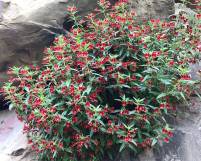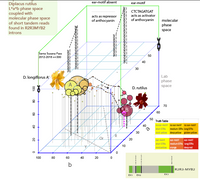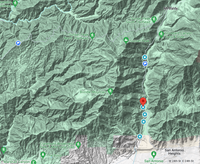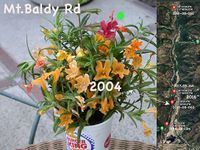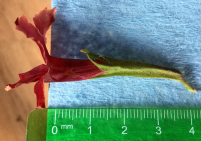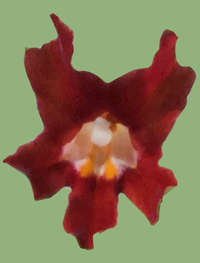Santa Susana Pass Transition
A worth seeing transition zone has formed along the Santa Susana Pass. If you want to see them, go first to Stoney Point Park and look around. In the shadow of the stone blocks grows Diplacus rutilus (It starts flowering from the middle to the end of April).
May 2023. In this zone one may find Diplacus individual plants in transition or pure D. rutilus individuals.
Note: Pure D. rutilus plants are still rare in this area (Fast transition)
Diplacus rutilus grows mainly in the shade of large boulders in this summer dry landscape. It turns out that the branches of this plant shorten this way, that the bush takes on a spherical shape. The transition takes about ten to fifteen years. D. rutilus develops from Diplacus longiflorus plant individuals (color phase space). D. rutilus, in its cushion shape, originated around the year 2010.
The tagged plant # 940 shows a significant floral color shift towards the dark rutilus type in a couple of years only (18-22). Every year flower shape of 10-50 adult plants becomes rutilus-like in the area. Also, here we have species formation on the fly. See also: https://academic.oup.com/evlett/article/7/5/293/7190212
We will inspect the additional sites mentioned above in Spring 2024.
The first phase model couples the phenotypes with the genotypes (color & R2R3Myb2 activity) here for Diplacus longiflorus and Diplacus rutilus with all intermediate stages. The model makes very reliable statements; see the truth table.
The TATA strings and the ear motif encode the gene activity of the MYB-TFs.
See: https://academic.oup.com/evlett/article/7/5/293/7190212 for genomic data.
Thanks to the authors for publishing the genomic data online. - We now know two ways of interpreting the Diplacus phenomenon. But we fear that only one interpretation will survive the test of time.
01-19-2024.
More Diplacus rutilus individuals have recently been seen in this area.
Note: Along Mt. Baldy Rd, we could see one plant with rutilus flowers only (bright green dot) in spring 2004. We sampled seeds along Mount Baldy Rd in 2010.



